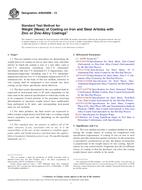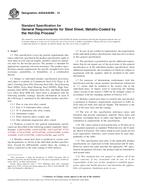We need your consent to use the individual data so that you can see information about your interests, among other things. Click "OK" to give your consent.
ASTM B832-93(2013)
Standard Guide for Electroforming with Nickel and Copper
STANDARD published on 1.12.2013
The information about the standard:
Designation standards: ASTM B832-93(2013)
Note: WITHDRAWN
Publication date standards: 1.12.2013
SKU: NS-8323
The number of pages: 9
Approximate weight : 27 g (0.06 lbs)
Country: American technical standard
Category: Technical standards ASTM
The category - similar standards:
Annotation of standard text ASTM B832-93(2013) :
Keywords:
copper, copper electroforming, electroforming, electroplating, mandrels, nickel, nickel electroforming, ICS Number Code 25.220.40 (Metallic coatings)
Additional information
| Significance and Use | ||||||||||||||||||||||||||||||||||||||
|
4.1 The specialized use of the electroplating process for electroforming results in the manufacture of tools and products that are unique and often impossible to make economically by traditional methods of fabrication. Current applications of nickel electroforming include: textile printing screens; components of rocket thrust chambers, nozzles, and motor cases; molds and dies for making automotive arm-rests and instrument panels; stampers for making phonograph records, video-discs, and audio compact discs; mesh products for making porous battery electrodes, filters, and razor screens; and optical parts, bellows, and radar wave guides (1-3).3 4.2 Copper is extensively used for electroforming thin foil for the printed circuit industry. Copper foil is formed continuously by electrodeposition onto rotating drums. Copper is often used as a backing material for electroformed nickel shells and in other applications where its high thermal and electrical conductivities are required. Other metals including gold are electroformed on a smaller scale. 4.3 Electroforming is used whenever the difficulty and cost of producing the object by mechanical means is unusually high; unusual mechanical and physical properties are required in the finished piece; extremely close dimensional tolerances must be held on internal dimensions and on surfaces of irregular contour; very fine reproduction of detail and complex combinations of surface finish are required; and the part cannot be made by other available methods. |
||||||||||||||||||||||||||||||||||||||
| 1. Scope | ||||||||||||||||||||||||||||||||||||||
|
1.1 This guide covers electroforming practice and describes the processing of mandrels, the design of electroformed articles, and the use of copper and nickel electroplating solutions for electroforming. 1.2 This standard does not purport to address all of the safety concerns, if any, associated with its use. It is the responsibility of the user of this standard to establish appropriate safety and health practices and determine the applicability of regulatory limitations prior to use. |
||||||||||||||||||||||||||||||||||||||
| 2. Referenced Documents | ||||||||||||||||||||||||||||||||||||||
|
Similar standards:
Historical
1.5.2009
Historical
1.5.2014
Historical
1.4.2013
Historical
1.5.2008
Historical
1.4.2013
Historical
15.4.2009
We recommend:
Technical standards updating
Do you want to make sure you use only the valid technical standards?
We can offer you a solution which will provide you a monthly overview concerning the updating of standards which you use.
Would you like to know more? Look at this page.



 ASTM A780/A780M-09..
ASTM A780/A780M-09.. ASTM A896/A896M-09(2..
ASTM A896/A896M-09(2.. ASTM A90/A90M-13..
ASTM A90/A90M-13.. ASTM A917-08
ASTM A917-08 ASTM A924/A924M-13..
ASTM A924/A924M-13.. ASTM B137-95(2009)..
ASTM B137-95(2009)..
 Cookies
Cookies
